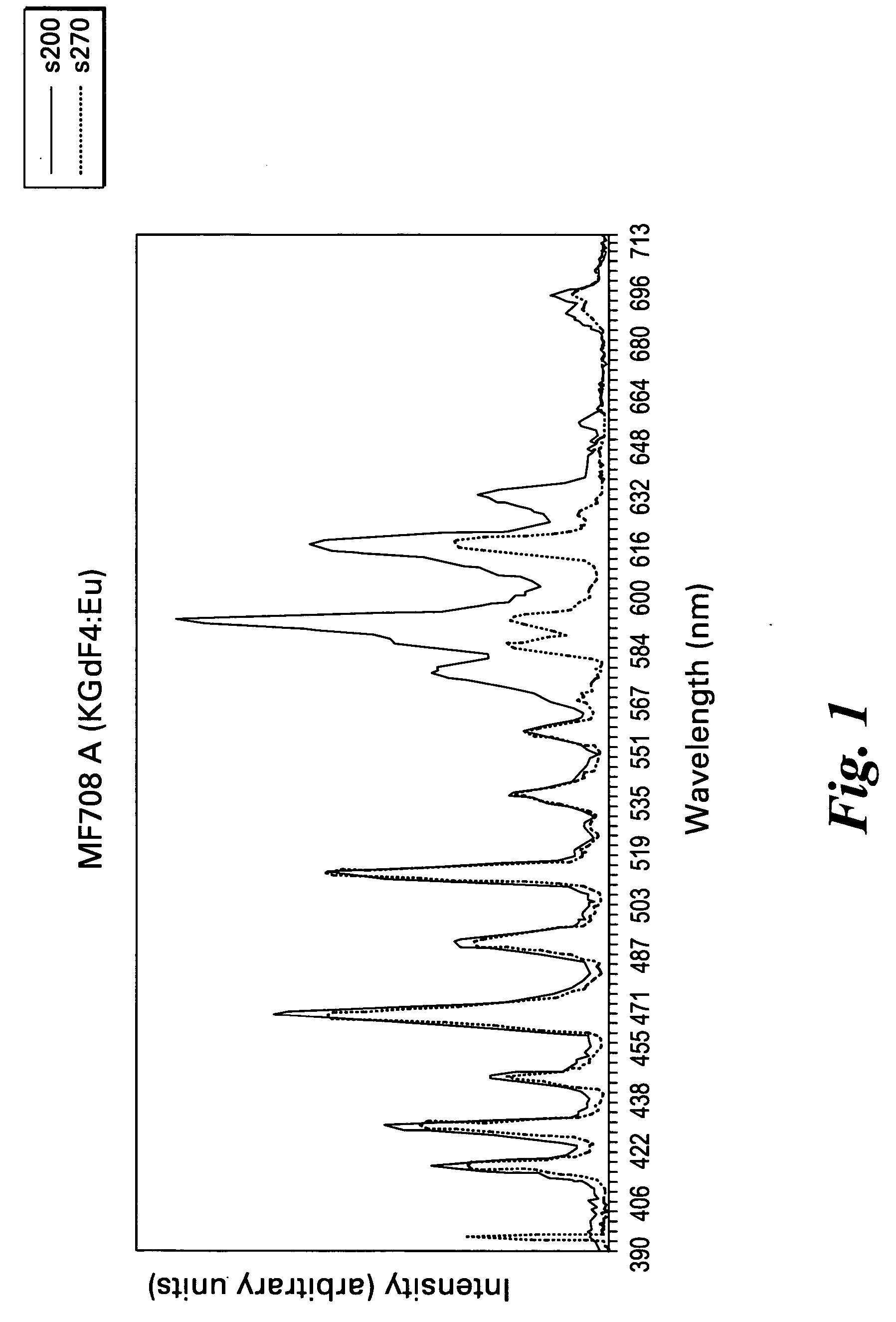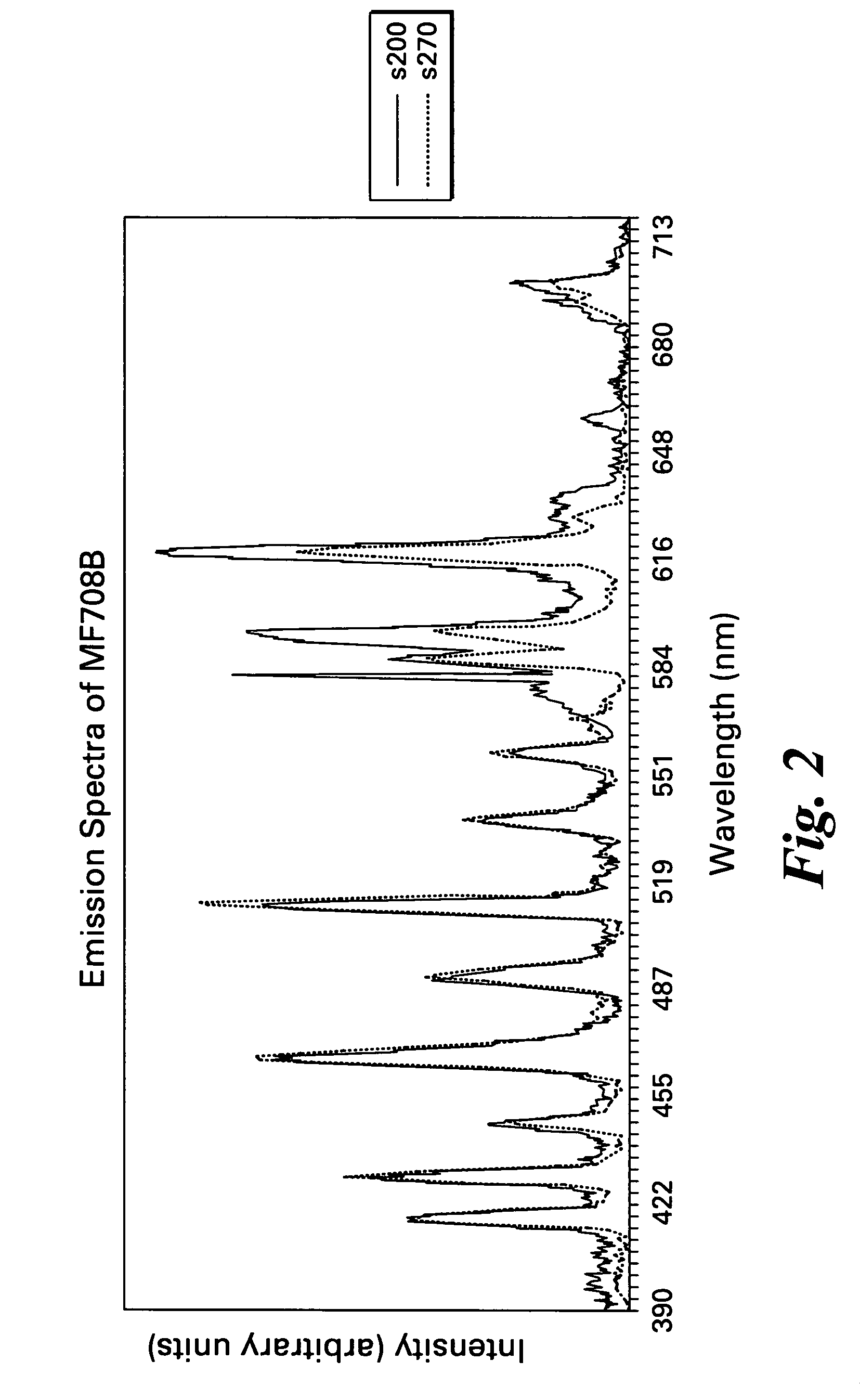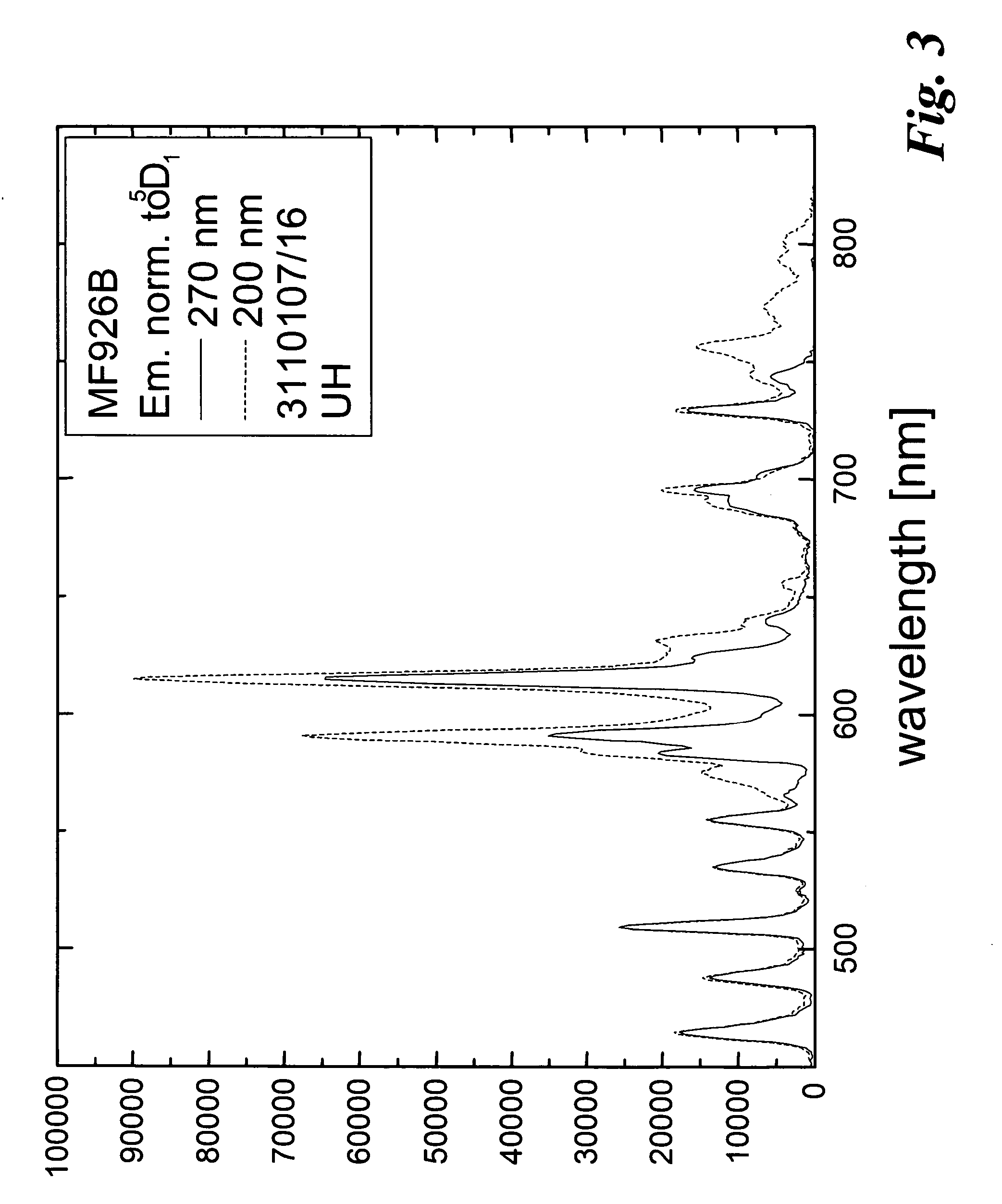Quantum-splitting fluoride-based phosphors, method of producing, and radiation sources incorporating same
a technology of fluoride-based phosphors and quantum-splitting fluoride, which is applied in the direction of discharge tube/lamp details, luminescent compositions, discharge tubes luminescent screens, etc., can solve the problems of difficult to produce fluoride-based materials, the stability of fluoride-based compounds in the art is not sufficient to permit their use as phosphors, and the cost of fluoride-based phosphors is relatively high. achieve the effect of improving
- Summary
- Abstract
- Description
- Claims
- Application Information
AI Technical Summary
Benefits of technology
Problems solved by technology
Method used
Image
Examples
example 1
Manufacture of Phosphors Having Formula of K1-yLiyGd1-xEuxF4
[0043] Table 1 shows the quantities of various fluorides, the heating temperature and times used to make the indicated potassium gadolinium fluoride phosphors activated with europium.
TABLE 1HeatingTempera-HeatingKFLiFGdF3EuF3tureTimexy(g)(g)(g)(g)(° C.)(hours)0.00101.278204.70880.004660080.00501.278204.68990.0229960080.0010.0051.06200.00243.93190.003861080.0050.0011.06580.00053.91460.01926108
[0044] The fluorides were blended together in an inert gas atmosphere. The mixture was placed in a silver tube, which was evacuated to less than 10−6 mm Hg. The tube was then backfilled with argon to about 1 atmosphere and sealed. The sealed tube was heated at the indicated temperature and for the indicated time. The emission spectra for the phosphors KGd0.999Eu0.001F4, KGd0.995Eu0.005F4, K0.995Li0.005Gd0.999Eu0.001F4, and K0.999Li0.001Gd0.995Eu0.005F4 are shown in FIGS. 1, 2, 3, and 4, respectively.
example 2
Manufacture of Phosphors Having Formula of Li1-yNayGd1-xEuxF4
[0045] Table 1 shows the quantities of various fluorides, the heating temperature and times used to make the indicated lithium gadolinium fluoride and lithium sodium gadolinium fluoride phosphors activated with europium.
TABLE 2HeatingTempera-HeatingLiFNaFGdF3EuF3tureTimexy(g)(g)(g)(g)(° C.)(hours)0.0010.0050.32260.00262.67540.002668050.0050.0010.32390.00052.66470.01316805
[0046] The fluorides were blended together in an inert gas atmosphere. The mixture was placed in a silver tube, which was evacuated to less than about 10−6 mm Hg. The tube was then backfilled with an amount of argon to about 1 atmosphere, and then sealed. The amount of argon was not critical. The sealed tube was then heated at the indicated temperature and for the indicated time. The emission spectra for the phosphors Li0.995Na0.001Gd0.999Eu0.001F4 and Li0.999Na0.001Gd0.995Eu0.005F4 are shown in FIGS. 5 and 6, respectively.
example 3
Manufacture of Fluoride-Based Quantum-Splitting Phosphors Sensitized with Bi or Sn
[0047] Table 3 shows the quantities of various fluorides, the heating temperature and times used to make the indicated potassium lithium gadolinium fluoride phosphors activated with europium, sensitized with Bi or Sn.
TABLE 3HeatingHeatingKFLiFGdF3EuF3BiF3 orTemperatureTimePhosphor(g)(g)(g)(g)SnF2 (g)(° C.)(hours)KLB-11.06560.00053.92540.00380.00496108KLB-21.06110.00243.89310.01920.02446108KLB-31.06020.00243.85050.03830.04886108KLS-11.06280.00243.89960.01920.01446108
[0048] The chemical formulas for the phosphors are:
KLB-1: K0.999Li0.001Gd0.98Eu0.001Bi0.001F4
KLB-2: K0.995Li0.005Gd0.99Eu0.005Bi0.005F4
KLB-3: K0.995Li0.005Gd0.98Eu0.01Bi0.01F4
KLS-1: K0.995Li0.005Gd0.99Eu0.005Sn0.005F4
[0049] The fluorides were blended together in an inert gas atmosphere. The mixture was placed in a silver tube, which was evacuated to less than about 10−6 mm Hg. The tube was then backfilled with an amount of argon to a...
PUM
 Login to View More
Login to View More Abstract
Description
Claims
Application Information
 Login to View More
Login to View More - R&D
- Intellectual Property
- Life Sciences
- Materials
- Tech Scout
- Unparalleled Data Quality
- Higher Quality Content
- 60% Fewer Hallucinations
Browse by: Latest US Patents, China's latest patents, Technical Efficacy Thesaurus, Application Domain, Technology Topic, Popular Technical Reports.
© 2025 PatSnap. All rights reserved.Legal|Privacy policy|Modern Slavery Act Transparency Statement|Sitemap|About US| Contact US: help@patsnap.com



